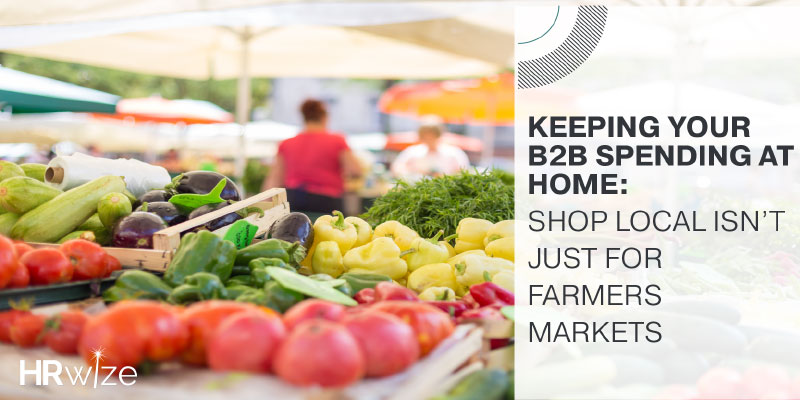Keeping your B2B spending at home: shop local isn’t just for farmers markets

Last weekend, my family and I were living the shop local life, walking around the farmer’s market to pick up some locally grown produce for the week’s meals and maybe a special treat from the local bakery. We came across many local restaurateurs sampling this year’s crop for inspiration for their menus and supporting the other local businesspeople in our area. It was a picture-perfect scene.
Watching this supportive dynamic between local businesses as an outsider made me wonder why the mantra of “shop local” seems to have found a niche in farmers’ markets and restaurants and hasn’t really reached the B2B scene. You don’t see companies advertising that their office supplies are made in Canada, or their promotional items came from a local vendor or are locally sourced. As a cloud-based software company, HRWize has a handful of local clients whom we love working with face to face and having the opportunity to develop a very strong relationship, but we also have many clients worldwide. This luxury is available to us by being cloud-based but hasn’t helped to push us to interact with our local business community and support our local economy as much as we would like (until now).
It’s great to see how in restaurants and small retail, the B2B spending gets reinvested locally, but we have that same power as businesses, with an exponential multiplier because our B2B spending is usually higher. A study done by Civic Economics showed that when buying from a local company 33% of the revenue remained in the local economy, versus buying from a multinational company where only 12% of the revenue remained (SOURCE: Civic Economics, Wist Office Products financial survey, Office Max Annual Reports). Especially in these recent trying times, that difference in reinvestment is significant. We realize that we need to make more of an effort to keep our B2B spending as local as possible to help stimulate and grow our own economy. This works in several ways:
- Labour costs are put back into the economy through wages and benefits paid to local employees who then reinvest in other local businesses.
- Business profits are kept more local based on the ownership of the company.
- This leads to charitable donations, where local businesses and CEO’s tend to volunteer and donate a higher percentage of revenue to local charities. They get to see first-hand where their dollars are being spent.
- Finally, in procurement of operational goods and services to keep the business running. Things like local contract work, office supplies and promotional items can all be sourced with ‘shop local’ in mind instead of from huge multinational companies.
There are many ways to get more information about shopping local in your communities. Often, government websites or tourism boards have a local business directory where you can list your own company as well as find other local businesses to work with. You can search locally online by adding your city or country name to find local businesses or check in with your local chamber of commerce.
It can be very convenient to do a quick online search and find a company in the United States or Europe who offers the B2B service you need, especially with all the cloud-based technology we currently rely on. However, taking a few moments to look through your local business directory could result in finding a neighbour who offers the same product or solution with better local service as well as a better understanding of your regional needs. Next time you’re looking for a new vendor, think #ShopLocal isn’t just for farmer’s markets and keep your B2B dollars local.
 A Year in ReviewBy Briana Della Foresta
A Year in ReviewBy Briana Della Foresta Choosing the Right HRIS: A Comprehensive GuideBy Briana Della Foresta
Choosing the Right HRIS: A Comprehensive GuideBy Briana Della Foresta The Impact of Vacation Time on Employee Creativity and InnovationBy Briana Della Foresta
The Impact of Vacation Time on Employee Creativity and InnovationBy Briana Della Foresta The Importance of Employee Vacations for Work-Life Balance By Briana Della Foresta
The Importance of Employee Vacations for Work-Life Balance By Briana Della Foresta Creating a Vacation-Friendly Company CultureBy Briana Della Foresta
Creating a Vacation-Friendly Company CultureBy Briana Della Foresta Strategies for Coping with Working Mom GuiltBy Briana Della Foresta
Strategies for Coping with Working Mom GuiltBy Briana Della Foresta The Importance of Respecting Holy DaysBy Briana Della Foresta
The Importance of Respecting Holy DaysBy Briana Della Foresta What HR Should Know About Candidate Experience?By Briana Della Foresta
What HR Should Know About Candidate Experience?By Briana Della Foresta Do What You Love or Love What You Do?By HRWize
Do What You Love or Love What You Do?By HRWize Diversity Requires MetricsBy Briana Della Foresta
Diversity Requires MetricsBy Briana Della Foresta

